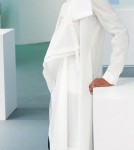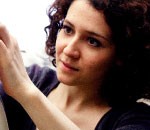An overview of SAIC’s Fashion Department
Photos and text by Jennifer Mosier
 Chicago-based designers have made powerful impressions on the fashion world – and as a result of that, the capital of the Midwest has made its mark as a fashion training ground.
Chicago-based designers have made powerful impressions on the fashion world – and as a result of that, the capital of the Midwest has made its mark as a fashion training ground.
SAIC’s Fashion Design Department produces designers and collections of noteworthy caliber, benefitting from the School’s artistic philosophy of allowing inspiration from other departments to influence the designers’ concepts.
SAIC embraces a conceptual approach to fashion, different from fashion schools that center their curriculum on the business aspects of the industry, like fashion marketing. Instead, there is a strong focus on the garment and its relationship to the body.
Students engage in deep explorations of the intellectual and creative facets of the fashion industry. Undergraduate and graduate programs focus on building relationships between art and fashion within current design practices
Fashion students are attracted to SAIC for those very reasons. “I chose SAIC because it was close to home but more because of the prestige and connection to the Art Institute of Chicago,” remarked Atalie Gagnet, sophomore fashion student. “I’m personally allowed to explore my own ideas and designs that emphasize my individual originality.”
Once accepted, it’s a three-year sequence of sleepless nights spent in a close marriage with the department’s sewing machines.
The fashion department has six full-time faculty (two of whom are full-time visiting artists), 17 part-time teachers and staff members who oversee the department.
 The core classes of the curriculum begin in the fall with Fashion and Construction Design. Amy Dane-Falkowski, the department’s Administrative Director, compares the curriculum to that of a design school in Europe. “We give students a full look at becoming a fashion designer,” she says. Students learn technical basics and are encouraged to think on a larger scale when it comes to enhancing their designs.
The core classes of the curriculum begin in the fall with Fashion and Construction Design. Amy Dane-Falkowski, the department’s Administrative Director, compares the curriculum to that of a design school in Europe. “We give students a full look at becoming a fashion designer,” she says. Students learn technical basics and are encouraged to think on a larger scale when it comes to enhancing their designs.
In addition to coursework, students can take advantage of a variety of resources. For instance, new additions to the department are the fashion labs, which are available to all students. They are intensive training grounds, tailored for students to enhance skills such as design construction or fashion illustration.
On the seventh floor of the Sullivan Building, just across the hall from Dane-Falkowski’s office, is the Fashion Resource Center, which holds an extensive collection of designer and couture garments, fashion-related books, archived runway shows and magazines.
As instructor and Assistant Director of the Fashion Resource Center, Caroline Bellios says, “This is not a museum. The resource center is a hands-on experience where we don’t have to wear white gloves.” Students are allowed to enter the giant walk-in closet and study the construction and design of garments as well as the hat and shoe collection, beginning in the 1960s and including a few 19th century specialty pieces.
In addition, the fashion department’s budget also goes toward equipment maintenance, instructional supplies, models on which to test garments, and small equipment purchases.
An even more valuable resource for students is the fact that the SAIC fashion department faculty and alumni are well connected to the fashion world, and they work with students throughout the program to find internships and jobs within the fashion industry.

With an alumni list boasting such notable designers as Cynthia Row, Maria Pinto, Matthew Ames and Gary Graham, it’s clear that the fashion department is producing designers meant to lead the industry, not just exist within it.
Each spring, the department hosts its annual FASHION show. While traditionally a select group of graduating seniors present their work at this show, May 2010 marks the inaugural graduation of MFA students from the Master of Design in Fashion, Body and Garment program, who will also be participating. Competition to participate in the show is fierce and students devote long, adruous hours in preparation for the event.
Wearing the students’ designs, professional models will walk the catwalk in the Modern Wing of the Art Institute of Chicago – a seminal use of the space for both the museum and the designers. For the graduating students, the show represents the culmination of a rigorous, conceptually challenging program, preparing them for the cutthroat world of fashion and design.





















